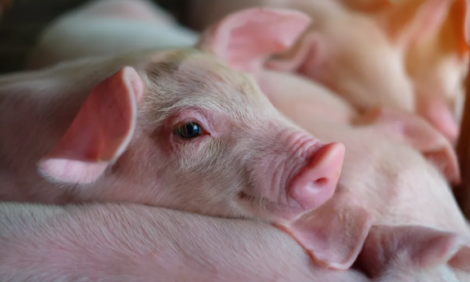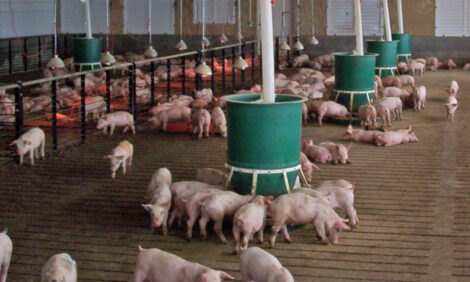



Control of PMWS in Spanish herds
B&M C.V.P, Consulting Veterinario Porcino, Barcelona, Spain - The first case of post-weaning multisystemic wasting syndrome (PMWS) was diagnosed in Spain in 1997. The disease affects pigs aged between 7 and 14 weeks and begins with the appearance of varied respiratory and digestive symptoms which produce a high mortality rate (5-20%), for which reason it is considered to be one of the most serious problems suffered by the swine industry in recent years.
 PMWS & PDNS
Technical Zone Back to the Technical Zone Sign up for the Mailing list Go to the Discussion Forum |
The aetiology of the disease is still not completely clear. Everything seems to indicate that a virus, Circovirus type II (PCV-II), appears to be the main causal agent, although there is evidence of herds that have been in contact with this agent and have not presented the typical clinical pattern. In fact, a retrospective study carried out by the Universidad Autónoma of Barcelona found sera extracted in 1986 to be positive to PCV-II.
Despite the fact that many doubts still exist regarding the aetiology, ways of infection, persistence of the disease on farm, etc., the losses suffered in field conditions have forced a series of measures to be taken in an attempt to mitigate the process. Such measures are based on common sense more than on actual knowledge of the disease, which explains why in some cases their efficiency does not meet with the expectations.
Control Measures
The disease has three characteristics which are basic to understanding the large number of proposed control measures:- The difficulty in reproducing the infection at experimental level and the need to use conventional pigs to reproduce the clinical symptoms as we know them, has lead us to believe that other infections must be present for the disease to be produced.
- When the disease affects between 10-30% of the pigs, generating between them a very high mortality rate (80% or more), the rest of the herd appears to be unaffected. It is normal for sick pigs to exist alongside perfectly healthy pigs in the same pen. A study carried out in France demonstrated that 51% of the animals affected came from 14.4% of the litters.
- Maintain the health balance on the farm
- Avoid contagion between the animals
- Favour the natural immune response of the animals
Maintaining the health balance on the farm
These measures are not new to swine herds, however, they are not usually strictly put into practice. They are designed to control the pressure of infection on the farm as much as possible.- Carry out All in – All out in the different rooms on the farm.
- Carry out adequate cleaning of rooms: empty and wash slurry channels, use a detergent to completely eliminate organic residuals, disinfect once the room is dry and allow it to dry out completely before introducing animals.
- Reduce the entry of replacement stock, maintain the health origin of same unchanged and submit stock to a sufficiently long and complete isolation and adaptation programme (at least 6 weeks) in order to avoid alterations in the reproductive herd. In some cases, it may be advisable to avoid the introduction of replacement stock for 3-4 months.
- In the worst case scenarios, it may be necessary to totally depopulate the flat decks for a period of 2-3 months. This is perhaps the most drastic measure, but it is the one that achieves the most spectacular, positive result. Even so, we cannot affirm that it is the definite solution. Some herds applying this type of procedure have not been able to eliminate the disease. Mortality rates have not returned to the levels that existed before suffering PMWS, but at least they have been considerably reduced.
Avoiding contagion
The most recommendable measure to avoid infection between animals on the farm is the perfect separation of the different age groups. To do this, it is necessary for the farrowing groups to be perfectly marked. In many cases, the change to a less frequent group system, for example, the change from weekly groups to 3-weekly groups, facilitates the demarcation of the different age groups, making the movement of animals between them difficult and avoiding infection. For each group there should be only one weaning day so that the ages of the piglets in the same group will gradually become homogenous.Excessive and late fostering of piglets must be avoided. The fostering of suckling piglets should be kept to a minimum (< 20% piglets adopted) and these should be carried out as early as possible (within the first two days post-farrowing) and always maintaining the movement of the piglets within the same farrowing group.
Increase hygiene during piglet handling:
- Disinfect the instruments used to cut teeth, tails and for castration between piglets: use two instruments so that the one not being used can be placed in a disinfectant solution.
- Disinfect correctly the umbilical cord and tie those which present a risk of breaking.
- Use a different needle in the syringe for each litter, both for injecting iron and when carrying out any kind of vaccination or treatment. Change the needle in the syringe for each flat deck or fattening pen when treatment is necessary.
Favouring the natural immune response
The first step to be taken to achieve a good immune response is to guarantee the correct colostrum intake of the piglets. A rapid assistance during farrowing, a good synchronisation and the application of techniques such as Split-nurse can be beneficial in assuring a correct colostrum intake.A good weaning weight will be essential in order for the piglet to confront the following phase with the maximum guarantees:
Control diarrhoea in farrowing rooms.
- Maximise the milk production of the sow, ensuring a correct supply of feed and water and avoiding temperatures of over 20°C.
- Wean the piglet at a minimum of 21 days. When the conditions of the flat decks are not the best, it could be interesting to delay the weaning age. The negative effect of stress on the immunity response of pigs is well known. Avoiding those factors which favour stress will, therefore, result in a better defence response and, consequently, in less losses:
- Guarantee correct temperature and ventilation conditions in the different phases.
- Avoid the movement of animals mid-way through any process.
- Avoid overcrowding: minimum 0.25 m²/pig up to 20 Kg. LW and 0.75m²/pig in the fattening phase.
- Administer high quality feed, both in palatability and digestibility, making sure that mycotoxins are not present. In case of doubt, the addition of a “capturing” substance could be of interest.
- Avoid the administration of vaccines coinciding with movements.
- Carry out correct parasite control.
Treatment
We have already commented that the response to antibiotics is not good and, in some cases, it can even prove to be negative, particularly when PMWS appears together with porcine dermatitis and nephropathy syndrome (PDNS), as, due to the presence of renal lesions, the elimination of the injected substances may be reduced.Generalised injectable treatments should be avoided as they may help to spread the process. Better results are achieved by applying them in water. In those cases where diarrhoea is one of the most evident symptoms present, the use of alternative substances could be of interest: acidifiers for example, in order to control secondary pathogens. The rapid separation of the affected animals into hospital pens, preferably isolated from the main herd, is recommended.
The application of all of these measures may help to mitigate the effects of PMWS. However, further investigation is necessary in order to discover much more effective methods of control and treatment.
B&M C.V.P, Consulting Veterinario Porcino, Barcelona, Spain - April 2001
 |
|
|
Consulting Veterinario Porcino Ctra. Rubí, 88 2º A Centre Negocis “Can Castanyer” 08190 SANT CUGAT DEL VALLES Barcelona, Spain |
Tel. 93 674 41 24 Fax. 93 675 39 58 E-mail: [email protected] |








